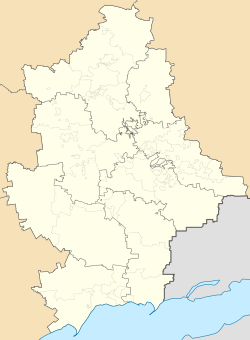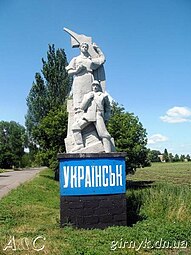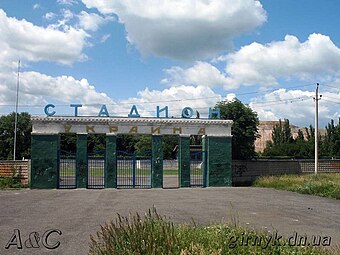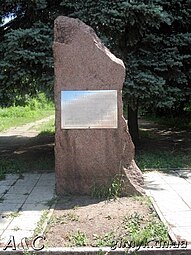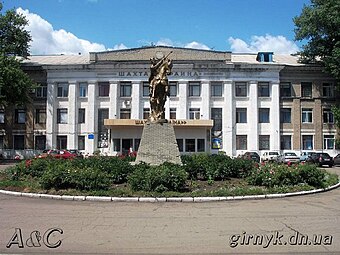Ukrainsk
 From Wikipedia - Reading time: 10 min
From Wikipedia - Reading time: 10 min
Ukrainsk
Українськ | |
|---|---|
 | |
| Coordinates: 48°06′N 37°23′E / 48.100°N 37.383°E | |
| Country | |
| Oblast | Donetsk Oblast |
| Raion | Pokrovsk Raion |
| Hromada | Selydove urban hromada |
| Founded | 1952 |
| City status | 1963 |
| Area | |
• Total | 4.2 km2 (1.6 sq mi) |
| Elevation | 210 m (690 ft) |
| Population (2022) | |
• Total | 10,655 |
| • Density | 2,500/km2 (6,600/sq mi) |
| Time zone | UTC+2 (EET) |
| • Summer (DST) | UTC+3 (EEST) |
| Postal code | 85485 |
| Area Code | +380 6236 |
| Climate | Dfb |
 | |
Ukrainsk (Ukrainian: Українськ, [ʊkrɐˈjinʲsʲk]; Russian: Украинск, [ʊkrɐˈinsk]) is a city in Selydove urban hromada, Pokrovsk Raion, Donetsk Oblast, Ukraine. Population: 10,655 (2022 estimate);[1] 13,236 (2001).[2]
Geography
[edit]The city of Ukrainsk is located 11km from the town of Selydove, not far from the international M04 (E50) motorway, and 4km from the Tsukuryne railway station, from which one can get to the towns of Kurakhove, Donetsk, Selydove and Pokrovsk.[3]
History
[edit]Founding and expansion
[edit]In 1952, geologists discovered large deposits of coking coal in proximity of the area of the later settlement. Following that, the settlement "Lisivka" was founded in connection with the construction of the "Lisivka" or later "Ukraina" ("Ukraine") coal mine), to exploit the newly discovered resources. It was followed by the construction of the Selydivska-Pivdenna coal mine.[4]
At the same time, residential construction was also underway. In 1957, elections to the village council were held and a territorial party organisation was established. In January 1962, the construction of the Selydivska-Pivdenna mine was completed, and a year later the "Ukraina" mine was completed. A enrichment plant and a motor depot were constructed.[4]
The village of Lisivska and Selydivska-Pivdenna mines were granted the status of urban-type settlements on 20 December 1957. In 1963 Lisivka received the status of a city and a new name derived from the name of the "Ukraina" mine.[3]
To accommodate newly arriving children of the workers, four schools were established. In 1967, a music school was also opened. More than a thousand children are brought up in eight kindergartens and nurseries. Additionally, a widescreen cinema "Ogonyk", a summer cinema, the club of the mine "Ukraina" and two libraries appeared.[4]
The town has been extensively improved: from 1964 to 1969, 45 multi-story residential buildings were constructed, and the town was well landscaped. 13 shops, a home kitchen and four canteens, two hospitals, an outpatient clinic and two pharmacies were built. Near the town, in Tsukrova Balka, a night sanatorium for the "Ukraina" mine was established.[4]
21st century and Russo-Ukrainian War
[edit]On 12 June 2020, according to the order of the Cabinet of Ministers of Ukraine № 710-r ‘On determining the administrative centres and approval of territories of territorial communities of Donetsk region’, the city became part of the Selydove urban hromada.[5][6]
On 17 July 2020, as a result of the administrative-territorial reform, in accordance with the Resolution of the Verkhovna Rada of Ukraine No. 807-IX, the Selydove urban hromada became part of the newly formed Pokrovsk Raion of the Donetsk Oblast.[7]
During the Russian invasion of Ukraine, Ukrainsk became a frontline city of the war.[8]
In late August 2024, as part of an offensive effort to capture the strategic city of Pokrovsk,[9] Russian forces advanced south of Pokrovsk, nearing the outskirts of Ukrainsk and Selydove, capturing nearby settlements.[8][10] In early September, Russian forces reportedly entered the city.[11][12] In mid September, the Russian forces captured large parts of the eastern and southern parts of the city.[13] Russian state-run RIA news agency and pro-Russian milbloggers stated that the city was captured on 17 September,[14] which was corroborated by geolocated footage.[15][16]
Demographics
[edit]At the 2001 Ukrainian census, the population was 13,236, of which the native language and ethnic distribution was:[2]
- Ethnicity
- Ukrainians: 48.38%
- Russians: 48.24%
- Belarusians: 1.32%
- Tatars: 0.37%
- Native language
- Russian: 76.40%
- Ukrainian: 23.08%
- Belarusian: 0.20%
Economy
[edit]The city of Ukrainsk relies heavily on the mining industry, particularly through the "Ukraine" coal mine and the coal processing plant (CPF "Ukraine"), both managed by the State Enterprise "Selidovugol." Most of the city's residents are employed in the mine.[3]
In 2008-2009, on the initiatives of the city mayor's office announced in the mass media, about 700 families from various regions of Ukraine moved to Ukrainsk. No more than 10% of the working population works at the "Ukraine" mine. The city has an asphalt plant, a bakery, several sewing workshops, and small car repair companies.[3]
Culture
[edit]Ukrainsk offers a range of community services, including secondary schools, kindergartens, a clinic, and a stadium. Children in the city have various opportunities to develop their talents, particularly at the House of Creativity.[17]
The city is home to several educational and cultural institutions. These include a music school named after V.G. Kuprienko, two physical education and sports institutions, one extracurricular educational center, and one healthcare facility. Notably, Vitaly Neshin and Rinat Akhmetov once honed their boxing skills here, representing "Spartak" in numerous tournaments.[3][17]
Among the schools are the "Children's and Youth Sports School" (DYSSh) of the "Ukraine" mine, named after ZMS V. V. Miroshnichenko, two preschool institutions—primary school No. 22 "Svitlyachok" and secondary school No. 18 "Kosmos"—as well as two secondary schools: secondary school No. 12 and secondary school No. 13.[18][17]
Attractions
[edit]The main attractions of the town are the following localities: the central square of the city; the mine "Ukraine"; a memorial sign in honor of the labor achievements of section No. 1 of the Ukraine mine; the city road sign at the entrance to Ukrainsk, the stadium "Ukraine" and the former cinema.[3]
Other sites include:[19]
- the monument to Bohdan Khmelnytsky (Oktyabrska street)
- stele of miner's glory (Komsomolska street)
- 2 commemorative signs near the SE "Shakhta" and SE "Selydivvugillia"
Gallery
[edit]-
Monument to Bohdan Khmelnytsky at the square near the administrative building of the mine "Ukraine"
-
Stele "Miner's Glory" at the entrance to the city, dedicated to the mine "Ukraine"
-
Stadium of Ukrainsk
-
Memorial plate for the section No. 1 of the "Ukraine" mine
-
Central square of Ukrainsk
-
Administrative office of the "Ukraine" mine
-
Former cinema of Ukrainsk
References
[edit]- ^ Чисельність наявного населення України на 1 січня 2022 [Number of Present Population of Ukraine, as of January 1, 2022] (PDF) (in Ukrainian and English). Kyiv: State Statistics Service of Ukraine. Archived (PDF) from the original on 4 July 2022.
- ^ a b "All-Ukrainian population census". db.ukrcensus.gov.ua. State Statistics Service of Ukraine. Retrieved 2024-08-26.
- ^ a b c d e f "Украинск - Шахтёрский край". girnyk.dn.ua. 2020-12-04. Retrieved 2024-08-30.
- ^ a b c d "Українськ, Донецька область". Історія міст і сіл Української РСР.
- ^ Автор. "Децентралізація в Україні". decentralization.gov.ua. Retrieved 2023-09-13.
- ^ "About determining administrative centers and approving the territories of territorial communities of Donetsk region". Cabinet of Ministers of Ukraine. 12 June 2020. Archived from the original on 1 July 2020. Retrieved 31 August 2024.
- ^ "Про утворення та ліквідацію р... | від 17.07.2020 № 807-IX". Verkhovna Rada of Ukraine. 2024-05-14. Archived from the original on 14 May 2024. Retrieved 2024-08-31.
- ^ a b "Selydove, Donetsk Oblast". DeepStateMap.Live. 28 August 2024.
- ^ Harward, Christina; Stepanenko, Kateryna; Hird, Karolina; Wolkov, Nicole; Trotter, Nate; Runkel, William; Wells, Katherine; Kagan, Frederick (23 October 2024). "Russian Offensive Campaign Assessment, October 23, 2024". Retrieved 25 October 2024.
- ^ "Russian troops capture Memryk and Kalynove in Donetsk Oblast – DeepState". The New Voice of Ukraine. 28 August 2024.
- ^ Kagan, Frederick W.; Evans, Angelica; Wolkov, Nicole; Gasparyan, Davit; Bailey, Riley (5 September 2024). "Russian Offensive Campaign Assessment, September 5, 2024". Institute for the Study of War. Retrieved 6 September 2024.
- ^ "Russian occupiers advance in Ukrainka and near Krasnohorivka — DeepState". The New Voice of Ukraine. 7 September 2024.
- ^ "DeepStateMAP | Мапа війни в Україні". DeepStateMap (in Ukrainian). Retrieved 2024-09-17.
- ^ "Russia captures Ukrainsk in east Ukraine, state media and war bloggers say". Reuters. 17 September 2024. Archived from the original on 17 September 2024. Retrieved 17 September 2024.
- ^ Barros, George; Mappes, Grace; Harward, Christina; Hird, Karolina; Zehrung, Haley; Evans, Angelica (17 September 2024). "Russian Offensive Campaign Assessment, September 17, 2024". Institute for the Study of War. Retrieved 17 September 2024.
- ^ Méheut, Constant (18 September 2024). "Russia Seizes Eastern Town as Ukraine Says It Hit a Big Ammunition Depot". The New York Times. Archived from the original on 18 September 2024. Retrieved 18 September 2024.
- ^ a b c "Історія - Українська міська рада". Ukrainsk City Council. 2019-03-23. Archived from the original on 26 January 2021. Retrieved 2024-08-31.
- ^ "Українська загальноосвітня школа І-ІІІ ступенів №12 Селидівської міської ради Донецької області | Реєстр суб'єктів освітньої діяльності". registry.edbo.gov.ua. Archived from the original on 31 August 2024. Retrieved 2024-08-31.
- ^ "Пам'ятні знаки - Українська міська рада". Ukrainska City Council. 2019-03-20. Archived from the original on 20 March 2019. Retrieved 2024-08-31.
Further reading
[edit]- Encyclopedia of Ukraine: Dictionary part: [in 11 volumes] / Shevchenko Scientific Society; Goal. ed. prof., Dr. Volodymyr Kubiyovych — Paris — New York: Young Life, 1955—1995. — ISBN 5-7707-4049-3
- Vasyl Pirko Settlement of Steppe Ukraine in XVI — XVIII century // Donetsk: Ukr. Center, 1998. - 124 p.
- Petro Lavriv. My land is the land of my parents. Donetsk, Ukrainian Cultural Center, Donetsk: Donetsk Regional Society of the Ukrainian Language named after T. G. Shevchenko, RVP "Swan". 1995. 64 p. Archived 2016-12-20 at the Wayback Machine
- Pirko V. O. Settlement of Donetsk region in the XVI-XVIII centuries (short historical sketch and excerpts from sources) Archived December 20, 2016, at the Wayback Machine / Ukrainian Cultural Center. —Donetsk: Eastern Publishing House, 2003. —180 p.
- Petro Lavriv. History of south-eastern Ukraine. Lviv. "Slovo", 1992. 152 p. ISBN 5-8326-0011-8
- M. A. Alfiorov. Shevchenko, LLC "Eastern Publishing House" 2012. — 552 p.
- M. A. Alfyorov. Migration processes and their impact on the socio-economic development of Donbas (1939—1959 years): monograph / M. A. Alfyorov; Ukraine cultural center, Donets. from Sciences. t-va named after Shevchenko. —Donetsk, 2008. —192 c.
 KSF
KSF

